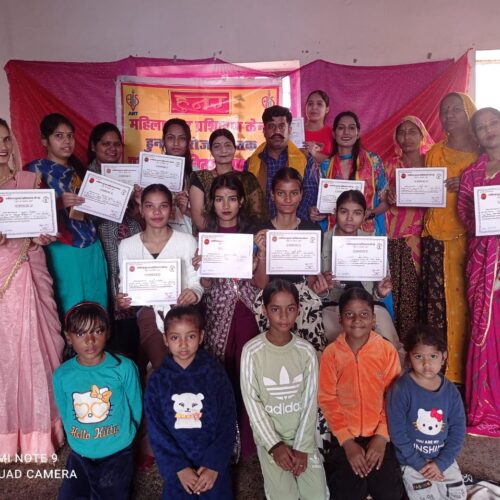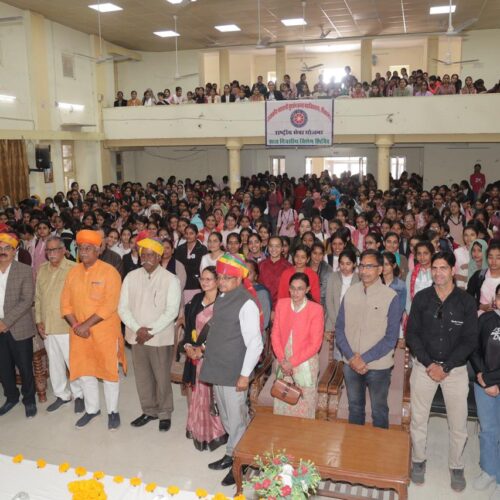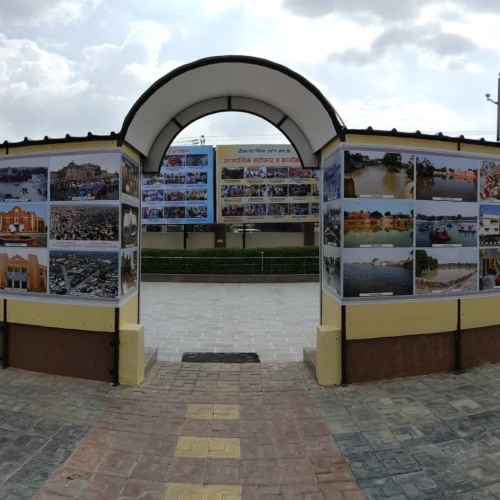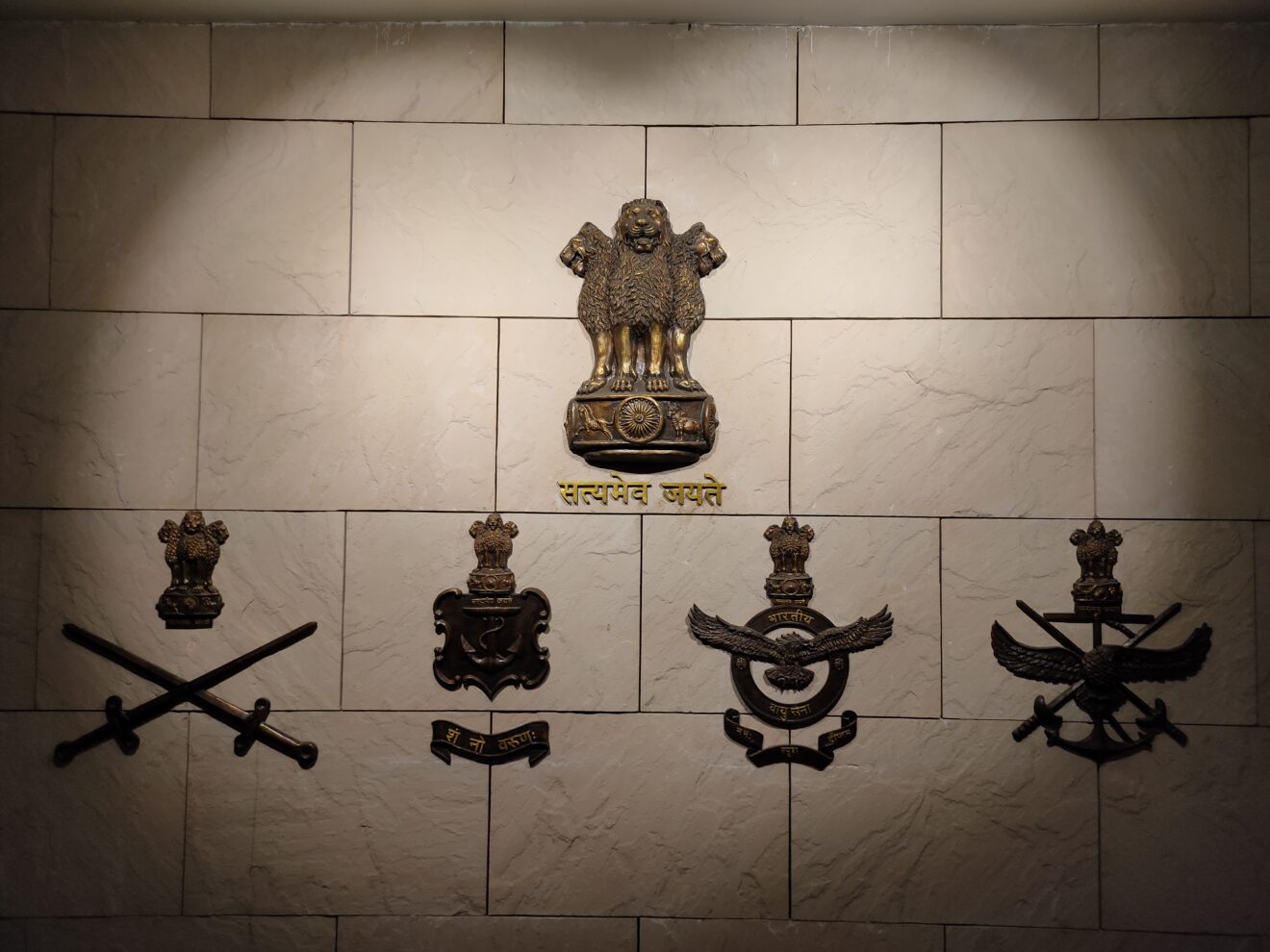BY DEFENCE JOURNALIST SAHIL | T.I.N. NETWORK
Strengthening Security Through Synergy: Lt Gen Manjinder Singh and DGP Rajeev Kumar Sharma Reinforce Military-Civil Fusion for Regional Stability
Jaipur / Rajasthan | October 15, 2025 — In a significant move towards fortifying the security architecture of north-western India, Lieutenant General Manjinder Singh, Army Commander, Sapta Shakti Command, held an extensive meeting with Shri Rajeev Kumar Sharma, Director General of Police, Rajasthan, at the Sapta Shakti Command Headquarters in Jaipur. The high-level discussion revolved around strengthening operational coordination, intelligence sharing, and rapid joint response mechanisms under the evolving framework of Military–Civil Fusion (MCF) — a concept now central to India’s integrated national security strategy.
This crucial interaction between the Indian Army’s desert command and the state’s top police leadership underscores the shared resolve to ensure synergy between military and civil security forces, enhancing preparedness across all fronts — from border defence to internal stability.
Military–Civil Fusion: The Backbone of Modern Security
The meeting between Lt Gen Singh and DGP Sharma was not a routine courtesy call — it represented a strategic dialogue between two pillars of India’s security establishment. The Military–Civil Fusion framework, inspired by global best practices and adapted to India’s diverse threat landscape, seeks to bridge operational gaps between military formations, police agencies, and civil administration for a faster, coordinated, and effective response to both conventional and unconventional threats.
Under this framework, joint operational planning, shared communication networks, and real-time intelligence exchange form the bedrock of modern security collaboration. For Rajasthan — a state that shares a sensitive border with Pakistan and has vast stretches of desert terrain — such synergy becomes even more critical.
The interaction reaffirmed the commitment of both institutions to enhanced inter-agency coordination, ensuring that Army and Police forces can operate with synchronized situational awareness during emergencies — be it cross-border infiltration, terror threats, cyber incidents, or natural disasters.
Lt Gen Manjinder Singh: Visionary Leadership for Integrated Defence
Lt Gen Manjinder Singh, known for his forward-looking strategic vision and operational acumen, has consistently emphasized that the future of national defence lies in integration and collaboration. As the commander of the Sapta Shakti Command, which oversees India’s crucial western sector stretching from Punjab to Rajasthan, his leadership has been marked by a strong focus on multi-domain readiness, rapid mobility, and technological modernization.
During the meeting, Lt Gen Singh highlighted the Indian Army’s readiness to support civil authorities whenever required and the importance of cross-domain understanding between security agencies. He stressed that synergy between the Army and Police is essential not only during conflict but also during peace — to preempt threats and ensure the safety of citizens across the region.
His approach reflects a larger national doctrine — one that aligns with Atmanirbhar Bharat’s holistic security vision, where every institution contributes to safeguarding the nation’s sovereignty and stability through seamless coordination.
DGP Rajeev Kumar Sharma: Policing with Precision and Partnership
Rajasthan’s Director General of Police, Shri Rajeev Kumar Sharma, a highly experienced officer with deep operational insight, has led several state-level reforms in intelligence, law enforcement, and community policing. Under his leadership, the Rajasthan Police has significantly enhanced its technical surveillance capabilities, border intelligence networks, and disaster response systems.
During the discussion, DGP Sharma emphasized the need for stronger interoperability between military and police forces, particularly in border districts such as Bikaner, Jaisalmer, Barmer, and Sriganganagar, where Army and Police often operate in close proximity.
He highlighted recent efforts in developing joint communication grids, shared training initiatives, and real-time alert systems to ensure that both forces can respond swiftly to any emerging situation. DGP Sharma further appreciated the Army’s support in civil operations, especially during natural calamities, border incidents, and counter-infiltration activities, acknowledging that such collaboration has saved countless lives over the years.
Key Areas of Discussion: Coordination, Joint Response & Mutual Support
The meeting primarily focused on three critical pillars of cooperation — Enhanced Coordination, Joint Response, and Mutual Support.
- Enhanced Coordination: Both leaders emphasized the need for streamlined communication channels between Army formations and state police headquarters. This includes setting up secure data networks for rapid intelligence transmission and situational updates.
- Joint Response: The idea of Joint Command Posts (JCPs) was discussed for use during emergencies, ensuring that Army and Police assets can be mobilized in tandem under unified command protocols.
- Mutual Support: Both sides reiterated their mutual commitment to assist each other in domains such as logistics, medical aid, humanitarian assistance, and public safety operations during crisis situations.
Additionally, the discussion covered border area surveillance, cyber and information warfare preparedness, and counter-drone operations, which are becoming increasingly vital given the rise in UAV-based cross-border threats.
Military–Police Cooperation: The Desert Sector Imperative
Rajasthan’s vast desert expanse poses unique challenges — from smuggling routes and infiltration corridors to natural calamities like sandstorms and flash floods. The Bikaner, Jaisalmer, and Barmer sectors often see both the Army and Police working shoulder to shoulder.
The recent Operation Sindoor and multiple joint training drills between Army and Police units in the desert belt have proven how integrated action leads to faster containment of threats and more effective humanitarian support. This latest engagement between Lt Gen Singh and DGP Sharma is thus a continuation of that joint legacy, ensuring that operational readiness across the Rajasthan frontier remains uncompromised.
Civil–Military Synergy Beyond Security
The dialogue also extended beyond purely operational issues, touching upon the role of civil–military cooperation in regional development, youth outreach, and nation-building.
Lt Gen Singh noted that the Army’s role in nation-building initiatives — including skill development programs for youth, environmental conservation drives, and infrastructure support in remote areas — complements the state police’s focus on community engagement and internal peace.
Both leaders discussed the importance of joint awareness campaigns, particularly in border villages, to build trust, prevent misinformation, and enhance local resilience against external manipulation or subversive activities.
Towards a Unified Security Ecosystem
The meeting concluded with a joint commitment to institutionalize regular military–police coordination conferences, joint situational assessments, and combined field training programs. A proposal for creating a permanent liaison mechanism between Sapta Shakti Command and Rajasthan Police Headquarters is also under consideration, which would allow for real-time collaboration during contingencies.
Lt Gen Manjinder Singh reiterated that modern security challenges — whether hybrid, cyber, or kinetic — demand a multi-layered, unified response. DGP Sharma agreed, adding that strong military–civil partnerships are the foundation of a stable and secure society.
Strategic Outlook: Sapta Shakti Command as a Hub of Integration
The Sapta Shakti Command, headquartered in Jaipur, has emerged as a hub of jointness and innovation in India’s western theatre. It has pioneered several integration initiatives such as Desert Warfare Seminars, Multi-Agency Coordination Exercises, AI-enabled surveillance networks, and joint police–army workshops.
Lt Gen Singh’s proactive leadership continues to drive a vision of “Security through Synergy”, ensuring that India’s western front remains robust, responsive, and ready for any eventuality.
Conclusion
The meeting between Lt Gen Manjinder Singh and DGP Rajeev Kumar Sharma marks another major step towards building a holistic and harmonized security ecosystem in Rajasthan and beyond. It symbolizes the Indian Army’s evolving doctrine — one where cooperation replaces compartmentalization, and coordination replaces crisis response delays.
As both uniformed institutions strengthen their partnership under the Military–Civil Fusion model, Rajasthan stands as a model of integrated security, where the combined strength of Army and Police ensures peace, stability, and preparedness across every inch of the desert frontier.
With such synergy at play, the message from Jaipur is clear — India’s safety is strongest when its institutions stand together.
BY DEFENCE JOURNALIST SAHIL | T.I.N. NETWORK
सहयोग से सशक्त सुरक्षा: लेफ्टिनेंट जनरल मंजींदर सिंह और डीजीपी राजीव कुमार शर्मा ने मिलिट्री–सिविल फ्यूज़न के तहत बढ़ाई समन्वय की ताकत
जयपुर / राजस्थान | 15 अक्टूबर 2025 —
उत्तर-पश्चिम भारत की सुरक्षा संरचना को और सुदृढ़ करने की दिशा में एक अहम कदम उठाते हुए सप्त शक्ति कमांड के आर्मी कमांडर लेफ्टिनेंट जनरल मंजींदर सिंह ने राजस्थान पुलिस महानिदेशक श्री राजीव कुमार शर्मा से जयपुर स्थित सप्त शक्ति कमांड मुख्यालय में विस्तृत बैठक की। यह उच्चस्तरीय बैठक “मिलिट्री–सिविल फ्यूज़न (MCF)” ढांचे के तहत आयोजित की गई, जिसका उद्देश्य था—सैन्य एवं नागरिक सुरक्षा तंत्र के बीच तालमेल, समन्वय और त्वरित संयुक्त प्रतिक्रिया क्षमता को और अधिक मजबूत करना।
इस मुलाकात ने एक बार फिर यह स्पष्ट किया कि भारत की सुरक्षा रणनीति अब पारंपरिक सीमाओं से आगे बढ़कर एकीकृत राष्ट्रीय सुरक्षा दृष्टिकोण की ओर अग्रसर है, जिसमें सेना और पुलिस दोनों ही एक-दूसरे के पूरक हैं।
मिलिट्री–सिविल फ्यूज़न: आधुनिक सुरक्षा का नया स्तंभ
लेफ्टिनेंट जनरल सिंह और डीजीपी शर्मा के बीच यह बैठक महज औपचारिक मुलाकात नहीं थी, बल्कि भारत के बदलते सुरक्षा परिवेश में रणनीतिक समन्वय की दिशा में एक ठोस संवाद थी।
मिलिट्री–सिविल फ्यूज़न का मूल सिद्धांत यह है कि सैन्य, पुलिस और नागरिक प्रशासन—तीनों के बीच ऐसा तंत्र विकसित हो, जिससे किसी भी स्थिति में संयुक्त कार्रवाई तत्काल और प्रभावी हो सके।
इस ढांचे के तहत रियल-टाइम इंटेलिजेंस शेयरिंग, संयुक्त संचार नेटवर्क, और संवेदनशील क्षेत्रों में त्वरित तैनाती योजनाएं तैयार की जा रही हैं।
राजस्थान जैसे सीमावर्ती राज्य में—जहां पाकिस्तान सीमा के साथ विशाल रेगिस्तानी इलाका फैला है—ऐसा समन्वय न केवल आवश्यक बल्कि अनिवार्य बन जाता है।
बैठक में इस बात पर विशेष बल दिया गया कि सेना और पुलिस दोनों ही किसी भी आपात स्थिति, चाहे वह सीमा पार घुसपैठ हो, आतंकवादी गतिविधि, साइबर हमला या प्राकृतिक आपदा—उसके प्रति एकीकृत और त्वरित प्रतिक्रिया देने में सक्षम हों।
लेफ्टिनेंट जनरल मंजींदर सिंह: एकीकृत रक्षा दृष्टिकोण के प्रणेता
लेफ्टिनेंट जनरल मंजींदर सिंह, जो अपनी दूरदर्शी सोच और रणनीतिक कौशल के लिए जाने जाते हैं, ने हमेशा यह कहा है कि आधुनिक राष्ट्रीय रक्षा का भविष्य “सहयोग और तालमेल” में निहित है।
सप्त शक्ति कमांड के प्रमुख के रूप में वे उस क्षेत्र की कमान संभालते हैं जो पंजाब से लेकर राजस्थान तक भारत के पश्चिमी मोर्चे का केंद्र है — जहां हर कदम पर सामरिक सतर्कता और तकनीकी दक्षता आवश्यक है।
उन्होंने बैठक के दौरान कहा कि भारतीय सेना किसी भी परिस्थिति में नागरिक प्रशासन का समर्थन करने के लिए सदैव तत्पर है।
उन्होंने इस बात पर जोर दिया कि सेना और पुलिस के बीच आपसी समझ और संयुक्त प्रशिक्षण, शांति के समय में भी सुरक्षा सुनिश्चित करने की कुंजी है।
उनका यह दृष्टिकोण प्रधानमंत्री मोदी के आत्मनिर्भर भारत विजन के अनुरूप है — जहां राष्ट्रीय सुरक्षा केवल सैन्य ताकत से नहीं, बल्कि सभी संस्थानों की एकजुट कार्यशैली से सुनिश्चित होती है।
डीजीपी राजीव कुमार शर्मा: समन्वित पुलिसिंग के प्रतीक
राजस्थान पुलिस के महानिदेशक श्री राजीव कुमार शर्मा एक अनुभवी और दूरदर्शी अधिकारी हैं, जिन्होंने राज्य में पुलिस व्यवस्था में कई सुधार लागू किए हैं।
उनके नेतृत्व में राजस्थान पुलिस ने सीमा सुरक्षा, तकनीकी निगरानी और इंटेलिजेंस नेटवर्क को नई दिशा दी है।
बैठक में उन्होंने इस बात पर विशेष ध्यान दिया कि सीमावर्ती जिलों—बीकानेर, जैसलमेर, बाड़मेर और श्रीगंगानगर—में सेना और पुलिस की संयुक्त कार्यवाही को और मजबूत किया जाए।
उन्होंने बताया कि पुलिस और सेना के बीच संयुक्त संचार प्रणाली, साझा प्रशिक्षण शिविर और रीयल-टाइम अलर्ट सिस्टम विकसित किए जा रहे हैं ताकि किसी भी खतरे पर तत्काल प्रतिक्रिया दी जा सके।
डीजीपी शर्मा ने यह भी कहा कि सेना के सहयोग से राज्य ने कई बार आपदा प्रबंधन, राहत कार्यों और सीमा घटनाओं का सफल समाधान किया है, जिससे असंख्य जानें बचाई जा सकीं।
तीन स्तंभों पर केंद्रित बैठक: समन्वय, संयुक्त प्रतिक्रिया और आपसी सहयोग
बैठक का मुख्य फोकस तीन प्रमुख स्तंभों पर था —
1. उन्नत समन्वय (Enhanced Coordination):
सेना और पुलिस के बीच संचार चैनलों को और सुदृढ़ करने पर चर्चा हुई। इसके तहत सुरक्षित डेटा नेटवर्क और त्वरित इंटेलिजेंस ट्रांसमिशन सिस्टम विकसित करने पर बल दिया गया।
2. संयुक्त प्रतिक्रिया (Joint Response):
आपात स्थितियों के दौरान जॉइंट कमांड पोस्ट (JCPs) की स्थापना पर विचार किया गया, ताकि सेना और पुलिस की टीमें एकीकृत कमान प्रणाली के तहत तुरंत कार्रवाई कर सकें।
3. आपसी सहयोग (Mutual Support):
दोनों संस्थाओं ने एक-दूसरे को लॉजिस्टिक्स, मेडिकल सहायता, मानवीय सहायता और सार्वजनिक सुरक्षा के क्षेत्रों में सहयोग देने के लिए अपनी प्रतिबद्धता दोहराई।
बैठक में ड्रोन और साइबर खतरे, सीमा निगरानी, और हाइब्रिड वारफेयर से निपटने के लिए साझा रणनीति पर भी गहन विचार-विमर्श हुआ।
मरुक्षेत्र की अनूठी चुनौतियाँ और संयुक्त तैयारी
राजस्थान का रेगिस्तानी भूभाग — जहां बीकानेर, बाड़मेर, जैसलमेर जैसे जिले सीमा के बेहद पास हैं — भारत के सुरक्षा ढांचे में अत्यंत संवेदनशील है।
यहां सेना और पुलिस दोनों को घुसपैठ, तस्करी, ड्रोन गतिविधियों और प्राकृतिक आपदाओं जैसी चुनौतियों का सामना करना पड़ता है।
हाल ही में ऑपरेशन सिंदूर और अन्य संयुक्त सैन्य-पुलिस अभ्यासों ने यह साबित किया है कि संयुक्त कार्यवाही और समन्वय से न केवल खतरों को तुरंत निष्क्रिय किया जा सकता है, बल्कि जनता की सुरक्षा को भी मजबूत बनाया जा सकता है।
यह बैठक उस सहयोग की निरंतरता है, जो राजस्थान फ्रंटियर की अटूट रक्षा का आधार बन चुकी है।
सुरक्षा से परे नागरिक–सैन्य सहयोग का विस्तार
बैठक का दायरा केवल सुरक्षा तक सीमित नहीं था, बल्कि राष्ट्र निर्माण, युवाओं के सशक्तिकरण और सामुदायिक विकास तक फैला हुआ था।
लेफ्टिनेंट जनरल सिंह ने बताया कि सेना न केवल सुरक्षा बल्कि रोज़गार, पर्यावरण संरक्षण और सामाजिक एकता के क्षेत्रों में भी योगदान दे रही है।
डीजीपी शर्मा ने भी कहा कि पुलिस और सेना का संयुक्त प्रयास युवाओं को राष्ट्रभक्ति, अनुशासन और सामुदायिक जिम्मेदारी के प्रति प्रेरित कर सकता है।
दोनों अधिकारियों ने सीमा क्षेत्रों में साझा जागरूकता अभियानों की योजना पर चर्चा की, ताकि फेक न्यूज़, अफवाहों और विदेशी प्रोपेगेंडा से निपटा जा सके।
निष्कर्ष: एकीकृत सुरक्षा की दिशा में राजस्थान का नया अध्याय
बैठक के अंत में दोनों अधिकारियों ने नियमित संयुक्त सम्मेलन, प्रशिक्षण कार्यक्रम और सिचुएशनल असेसमेंट बैठकों को संस्थागत रूप देने पर सहमति जताई।
साथ ही, सप्त शक्ति कमांड और राजस्थान पुलिस मुख्यालय के बीच एक स्थायी संपर्क तंत्र (Liaison Mechanism) स्थापित करने का प्रस्ताव भी विचाराधीन है।
लेफ्टिनेंट जनरल मंजींदर सिंह ने कहा — “आधुनिक सुरक्षा चुनौतियाँ चाहे साइबर हों या हाइब्रिड — उनका मुकाबला केवल एकजुट और समन्वित दृष्टिकोण से ही संभव है।”
डीजीपी शर्मा ने भी सहमति जताते हुए कहा — “मजबूत सैन्य–नागरिक साझेदारी ही स्थिर और सुरक्षित समाज की आधारशिला है।”
यह बैठक इस बात का प्रतीक है कि भारत की सुरक्षा सबसे मजबूत तब होती है जब उसकी संस्थाएँ एकजुट होकर खड़ी होती हैं।














Add Comment